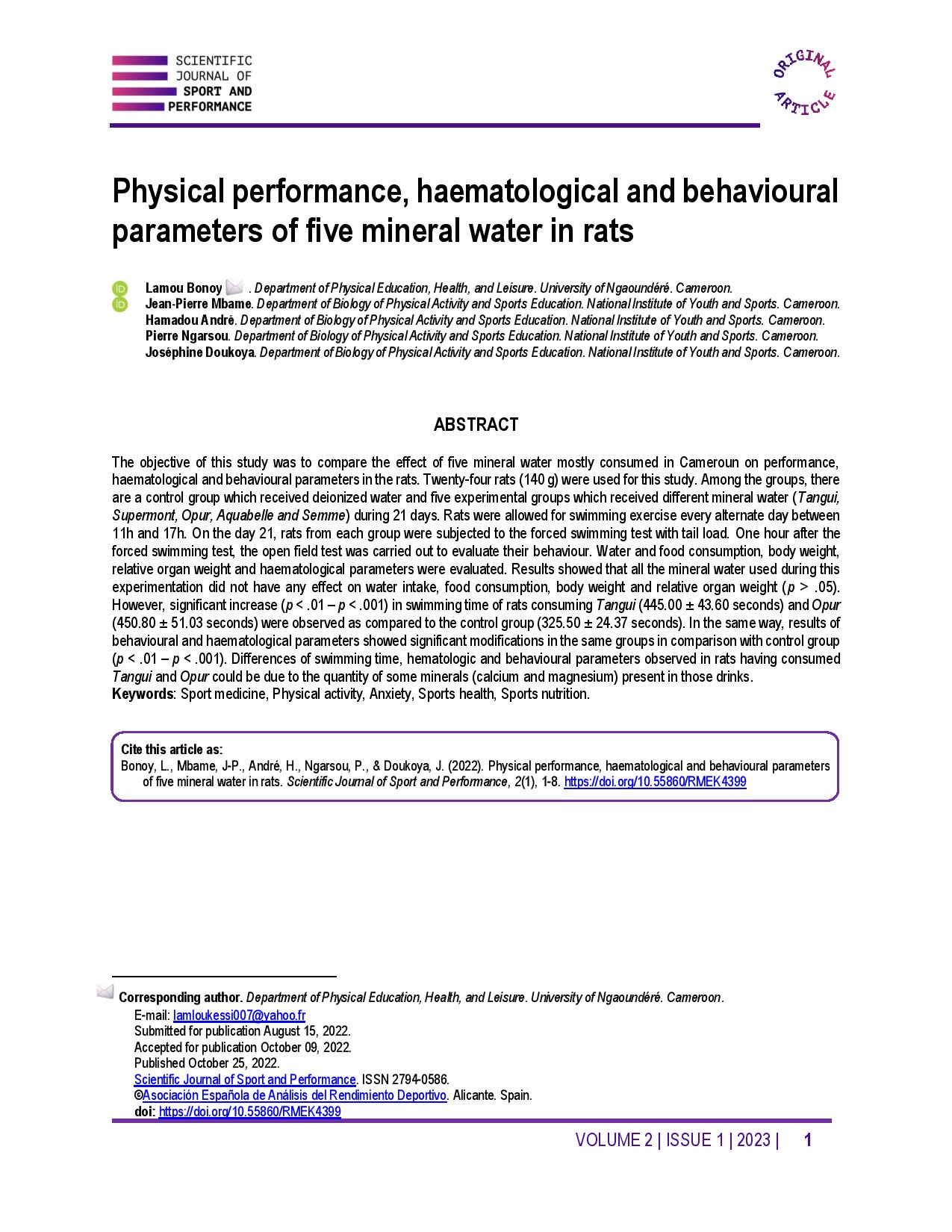Physical performance, haematological and behavioural parameters of five mineral water in rats
Main Article Content
Abstract
The objective was to compare the effect of five mineral water mostly consumed in Cameroun on performance, haematological and behavioural parameters in rats. Twenty-four rats (140 g) were used for this study. Among the groups, there are a control group which received deionized water and five experimental groups which received different mineral water (Tangui, Supermont, Opur, Aquabelle and Semme) during 21 days. Rats were allowed for swimming exercise every alternate day between 11h and 17h. On the day 21, rats from each group were subjected to the forced swimming test with tail load. One hour after the forced swimming test, the open field test was carried out to evaluate their behaviour. Water and food consumption, body weight, relative organ weight and haematological parameters were evaluated. Results showed that all the mineral water used during this experimentation did not have any effect on water intake, food consumption, body weight and relative organ weight (p > .05). Significant increase (p < .01 – p < .001) in swimming time of rats consuming Tangui (445.00 ± 43.60 seconds) and Opur (450.80 ± 51.03 seconds) were observed as compared to the control group (325.50 ± 24.37 seconds). Results of behavioural and haematological parameters showed significant modifications in the same groups in comparison with control group (p < .01 – p < .001). Differences of swimming time, hematologic and behavioural parameters observed in rats having consumed Tangui and Opur could be due to the quantity of some minerals (calcium and magnesium) present in those drinks.
Article Details

This work is licensed under a Creative Commons Attribution-NonCommercial-ShareAlike 4.0 International License.
References
Belzung, C. (1999). Measuring rodent exploratory behavior. Handbook of Molecular-Genetic techniques. Brain and Behavioral Research, 11: 738-749. https://doi.org/10.1016/S0921-0709(99)80057-1 DOI: https://doi.org/10.1016/S0921-0709(99)80057-1
Bigard, A. X. (2007). Apports en protéines et Exercices. In Nutrition du Sportif, Bigard AX, Guezennec CY, Collection «Sport». Masson éditeurs, Paris, 235 p. https://doi.org/10.1016/B978-2-294-08871-1.50004-0 DOI: https://doi.org/10.1016/B978-2-294-08871-1.50004-0
Gibson, R.S., Bailey, K.B., Gibbs, M. and Ferguson, E.L. (2010). A review of phytate, iron, zinc, and calcium concentrations in plant-based complementary foods used in low-income countries and implications for bioavailability. Food Nutrition Bulletin, 31: S134-S146. https://doi.org/10.1177/15648265100312S206 DOI: https://doi.org/10.1177/15648265100312S206
Heffernan, S.M., Horner, K., De Vito, G. and Conway G.E. (2019). The role of mineral and trace element supplementation in exercise and athletic performance: a systematic review. Nutrients, 11: 696. https://doi.org/10.3390/nu11030696 DOI: https://doi.org/10.3390/nu11030696
Hsieh, M., Roth, R., Davis, D. L., Larrabee, H. and Callaway, C. W. (2002). Hyponatremia in runners requiring on-site medical treatment at a single marathon. Medicinal Sciences in Sports Exercises, 34: 182-185. https://doi.org/10.1097/00005768-200202000-00001 DOI: https://doi.org/10.1097/00005768-200202000-00001
Institut Français pour la Nutrition, (2010). Lettre scientifique IFN N° 142, mars 2010.
Kamakura, M., Mitani, N., Fukuda, T. and Fukushima, M. (2001). Antifatigue effect of fresh Royal jelly in mice. Journal of Nutritional Science and Vitaminology. 47(6): 394-401. https://doi.org/10.3177/jnsv.47.394 DOI: https://doi.org/10.3177/jnsv.47.394
Kerksick, C.M., Wilborn, C.D., Roberts, M.D., Smith-Ryan, A., Kleiner, S.M., Jager, R., Collins, R., Cooke, M., Davis, J.N. and Galvan, E. (2018). ISSN exercise & sports nutrition review update: Research & recommendations. Journal of the International Society of Sports Nutrition, 15: 38. https://doi.org/10.1186/s12970-018-0242-y DOI: https://doi.org/10.1186/s12970-018-0242-y
Lamou, B., Sotoing, T. G., Hamadou, A., Abene, Houlray, J., Mey, A. M. and Vernyuy T. P. (2016). Antioxidant and antifatigue properties of the aqueous extract of Moringa oleifera in rats subjected to force swimming endurance test. Oxidative Medicine and Cellular Longevity, 1-9. https://doi.org/10.1155/2016/3517824 DOI: https://doi.org/10.1155/2016/3517824
Lazarte, C.E., Carlsson, N.G., Almgren, A., Sandberg, A.S. and Granfeldt, Y. (2015). Phytate, zinc, iron and calcium content of common Bolivian food, and implications for mineral bioavailability. Journal of Food Composition and Analysis, 39: 111-119. https://doi.org/10.1016/j.jfca.2014.11.015 DOI: https://doi.org/10.1016/j.jfca.2014.11.015
Matsumoto, K., Ishihara, K., Tanaka, K., Inoue, K. and Fushiki, T. (1996). An adjustable current swimming pool for the evaluation of endurance capacity of mice. Journal of Applied Physiology, 81(4): 1843-1849. https://doi.org/10.1152/jappl.1996.81.4.1843 DOI: https://doi.org/10.1152/jappl.1996.81.4.1843
Misner, B. (2006). Food alone may not provide sufficient micronutrients for preventing deficiency. Journal of the International Society of Sports Nutrition, 3: 51-55. https://doi.org/10.1186/1550-2783-3-1-51 DOI: https://doi.org/10.1186/1550-2783-3-1-51
Qi, B., Liu, L., Zhang, H., Zhou, G. X., Wang, S. and Duan, X. Z. (2014). Anti-fatigue effects of proteins isolated from Panax quinquefolium. Journal of Ethnopharmacology. 153(2): 430-434. https://doi.org/10.1016/j.jep.2014.02.045 DOI: https://doi.org/10.1016/j.jep.2014.02.045
Shi, X. (2004). Gastrointestinal discomfort during intermittent high-intensity exercise: effect of carbohydrate-electrolyte beverage. International Journal of Sports Nutrition and Exercise Metabolism, 14 (6): 673-683. https://doi.org/10.1123/ijsnem.14.6.673 DOI: https://doi.org/10.1123/ijsnem.14.6.673
Walsh, R. M., Noakes, T. D., Hawley, J. A. and Dennis, S. C. (1994). Impaired highintensity cycling performance time at low levels of dehydration. International Journal of Sports Medicine, 15: 392. https://doi.org/10.1055/s-2007-1021076 DOI: https://doi.org/10.1055/s-2007-1021076




